Demonstration of 5G Solutions for Smart Energy Grids of the Future: A Perspective of the Smart5Grid Project
Abstract
:1. Introduction
- (1)
- The introduction of the NetApp concept to enhance the capabilities of domain-specific applications for one of the most important 5G vertical industries, that is, the power and energy grid. This concept takes into account the 5G SBA and provides a joint framework for application and network management, among others.
- (2)
- The definition of an open cross-domain platform, which includes the energy and the telecommunication domain and the Smart5Grid open-experimentation platform, along with open interfaces for third parties to assess their custom energy-related NetApps.
- (3)
- The presentation of a set of different use cases with different communication requirements and their impact on the definition and interplay between the Smart5Grid components.
1.1. Main Functionalities of Smart Grids
- (1)
- Advanced metering and monitoring for close to real-time transmission and reception of data for information, monitoring, and control purposes of the energy network to acquire/provide feedback for the grid operation and enable consumers to better manage consumptions.
- (2)
- Active network management for operational optimization through predictive maintenance, energy network remote reconfiguration, and recovery scheme activation in almost real time.
- (3)
- Flexibility services from DERs, such as distributed generation, energy storage assets, and demand-side response, leveraging end-user flexibility.
- (4)
- Smart charging services, such as vehicle-to-grid or vehicle-to-home solutions (for battery electric and plug-in hybrid vehicles) and additional growth of electrification grade (i.e., heating and cooling), increasing RESs’ grid hosting capability.
1.2. The Solution Proposed in the Smart5Grid Project
- (1)
- An innovative cross-border frequency monitoring system will be implemented to support the regional transmission system operator (TSO) to provide system stability.
- (2)
- A safety system for workers in HV power substations will also be developed, ensuring that workers (and their tools) keep the due physical distance from the live parts of the substation, as electricity still represents a danger for workers if the risks in HV power substations are not properly addressed.
- (3)
- An advanced active grid management system will be designed to provide real-time communication monitoring, preparing the ground for further implementation of edge-based computing.
- (4)
- Real-time monitoring and control of DERs will be also implemented, creating the basis for providing flexibility services to the energy system operators.
2. Smart5Grid NetApp Concept
3. Smart5Grid Platform
3.1. Main Functionality and Actors
3.2. Reference Architecture
3.2.1. Platform Layer
OSR
V&V Framework
3.2.2. NFV/Telco Layer
M&O Framework
- (1)
- The dynamic provisioning of end-to-end network slices, both at the infrastructure level (infrastructure chunks) as well as at the network level (networks chunks), bearing in mind the performance requirements per slice, such as QoS policies.
- (2)
- The clients and third parties handle the network slices’ lifecycle management (LCM) in an agile manner in terms of commissioning, deployment, fault, and configuration procedures performed over the chunking resources and the network slices (NS).
- (3)
- The interaction with the virtual infrastructure manager (VIM) technologies for the management of edge/cloud infrastructures, such as OpenStack, provide better support of multi-tenancy and multi-tier services. In addition, it interacts with ETSI NFV MANO frameworks, such as the open-source NVF management and orchestration (OSM), to coordinate the network services’ LCM procedures in a multi-tier model.
- (4)
- Seamless and dynamic network service provisioning at the network level by establishing the service chain communication among several network functions, which together describe a NetApp. These NetApps can be distributed along with the multiple infrastructure domains.
- (5)
- A flexible interaction with open radio access network (O-RAN) [28] aligned access networks to enable a transparent and dynamic resource orchestration of the multiple wireless devices such as small cells, Wi-Fi networks, and 5 New Radio (NR).
NFV/Telco Infrastructure
3.2.3. Smart Energy Grid Layer
4. Smart5Grid NetApp Use Cases
4.1. UC1—Automatic Power Distribution Grid Fault Detection
4.1.1. Description
4.1.2. Requirements
4.1.3. Specific NetApps
4.1.4. Site Architecture
4.2. UC2—Remote Inspection of Automatically Delimited Working Areas at Distribution Power Systems
4.2.1. Description
4.2.2. Requirements
4.2.3. Specific NetApps
4.2.4. Site Architecture
4.3. UC3—Millisecond-Level Precise Distributed Generation Monitoring
4.3.1. Description
4.3.2. Requirements
4.3.3. Specific NetApps
4.3.4. Site Architecture
4.4. UC4—Real-Time Wide Area Monitoring
4.4.1. Description
4.4.2. Requirements
4.4.3. Specific NetApps
4.4.4. Site Architecture
4.5. Summary of Use Cases elements
5. Conclusions
Author Contributions
Funding
Acknowledgments
Conflicts of Interest
Disclaimer
Nomenclature
| Acronym | Description |
| A&A | Authentication and authorization |
| API BSS | Application Programming Interface Battery Storage System |
| CN | Core Network |
| CPs | Connection Points |
| DERs | Distributed Energy Resources |
| DevOps | Development and Operations |
| DSO eMBB | Distribution System Operator Enhanced Mobile Broadband |
| EU | European Union |
| ETSI | European Telecommunications Standards Institute |
| HIL HV | Hardware-in-the-Loop High Voltage |
| IMT | Information Model Translation |
| KPIs | Key Performance Indicators |
| LCM | Lifecycle Management |
| M&O | Management and Orchestration |
| MEC | Multiple-Access Edge Computing |
| MECO mMTC | Multiple-Access Edge Computing Orchestrator Massive Machine Type Communication |
| MV | Medium Voltage |
| NFMF | Network Function Management Function |
| NFV | Network Function Virtualization |
| NFVO | Network Function Virtualization Orchestrator |
| NSD | Network Service Descriptor |
| NSI | Network Slice Instance |
| NSSMF OPCs | Network Slice Subnet Management Function Open Platform Communications |
| O-RAN OSM | Open Radio Access Network Open-Source NVF Management and Orchestration (MANO) |
| OSR PMU PV | Open Service Repository Phasor Measurement Unit Photovoltaic |
| QoS | Quality of Service |
| RAN | Radio Access Network |
| RESs | Renewable Energy Sources |
| SAPD | Service Access Point Descriptor |
| SLO | Service Level Objective |
| SM | Slice Manager |
| SMEs SW | Small- and Medium-Sized Enterprises Software |
| TSO | Transmission System Operator |
| UC | Use Case |
| UE | User Equipment |
| UPF URLLCs UWB | User Plane Function Ultra-Reliable Low Latency Communications Ultra-Wide Band |
| V&V | Verification and Validation |
| VDU | Virtual Digital Unit |
| VIM | Virtualization Infrastructure Manager |
| VNF | Virtual Network Function |
| VNFD WT | Virtual Network Function Descriptor Wind Turbine |
References
- Kezunovic, M.; Vittal, V.; Meliopoulos, S.; Mount, T. The Big Picture: Smart Research for Large-Scale Integrated Smart Grid Solutions. IEEE Power Energy Mag. 2012, 10, 22–34. [Google Scholar] [CrossRef]
- EC Cooperation Group of Smart Grid, Energy Storage, Islands and Digitalisation H2020 Projects—European Union. Available online: https://www.h2020-bridge.eu (accessed on 18 November 2021).
- Elavarasan, R.M.; Shafiullah, G.M.; Padmanaban, S.; Kumar, N.M.; Annam, A.; Vetrichelvan, A.M.; Mihet-Popa, L.; Holm-Nielsen, J.B. A Comprehensive Review on Renewable Energy Development, Challenges, and Policies of Leading Indian States with an International Perspective. IEEE Access 2020, 8, 74432–74457. [Google Scholar] [CrossRef]
- Telukunta, V.; Pradhan, J.; Agrawal, A.; Singh, M.; Srivani, S.G. Protection Challenges under Bulk Penetration of Renewable Energy Resources in Power Systems: A Review. CSEE J. Power Energy Syst. 2017, 3, 365–379. [Google Scholar] [CrossRef]
- Showers, S.O.; Raji, A.K. Benefits and Challenges of Energy Storage Technologies in High Penetration Renewable Energy Power Systems. In Proceedings of the 2019 IEEE PES/IAS PowerAfrica, Abuja, Nigeria, 20–23 August 2019; pp. 209–214. [Google Scholar]
- Falkoni, A.; Pfeifer, A.; Krajačić, G. Vehicle-to-Grid in Standard and Fast Electric Vehicle Charging: Comparison of Renewable Energy Source Utilization and Charging Costs. Energies 2020, 13, 1510. [Google Scholar] [CrossRef] [Green Version]
- Cupelli, L.; Cupelli, M.; Ponci, F.; Monti, A. Data-Driven Adaptive Control for Distributed Energy Resources. IEEE Trans. Sustain. Energy 2019, 10, 1575–1584. [Google Scholar] [CrossRef]
- Ferdowsi, M.; Benigni, A.; Monti, A.; Ponci, F. Measurement Selection for Data-Driven Monitoring of Distribution Systems. IEEE Syst. J. 2019, 13, 4260–4268. [Google Scholar] [CrossRef]
- Almehizia, A.A.; Al-Masri, H.M.K.; Ehsani, M. Integration of Renewable Energy Sources by Load Shifting and Utilizing Value Storage. IEEE Trans. Smart Grid 2019, 10, 4974–4984. [Google Scholar] [CrossRef]
- Albu, M.M.; Sănduleac, M.; Stănescu, C. Syncretic Use of Smart Meters for Power Quality Monitoring in Emerging Networks. IEEE Trans. Smart Grid 2017, 8, 485–492. [Google Scholar] [CrossRef]
- Kotsonias, A.; Hadjidemetriou, L.; Asprou, M.; Kyriakides, E. Performance Investigation of a Monitoring Scheme for Low Voltage Grids with a Single Grounded Neutral. In Proceedings of the 2019 IEEE Milan PowerTech, Milano, Italy, 23–27 June 2019; pp. 1–6. [Google Scholar]
- Monti, A.; Huitema, G.; Sayed-Mouchawe, M.; Amezua, A.; Beard, L.; Borst, T.; Carvalho, M.; Conde, A.; Dimeas, A.; Giraud, G.; et al. Digitalization of the Electricity System and Customer Participation; European Commission ETIP-SNET: Brussels, Belgium, 2018. [Google Scholar]
- Deng, R.; Yang, Z.; Chow, M.-Y.; Chen, J. A Survey on Demand Response in Smart Grids: Mathematical Models and Approaches. IEEE Trans. Ind. Inform. 2015, 11, 570–582. [Google Scholar] [CrossRef]
- Gungor, V.C.; Sahin, D.; Kocak, T.; Ergut, S.; Buccella, C.; Cecati, C.; Hancke, G.P. Smart Grid Technologies: Communication Technologies and Standards. IEEE Trans. Ind. Inform. 2011, 7, 529–539. [Google Scholar] [CrossRef] [Green Version]
- Mouftah, H.T.; Erol-Kantarci, M. Chapter 25—Smart Grid Communications: Opportunities and Challenges. In Handbook of Green Information and Communication Systems; Academic Press: Cambridge, MA, USA, 2013; pp. 631–663. ISBN 978-0-12-415844-3. [Google Scholar]
- Sykes, J.; Day, D.; Fennelly, K.; Skendzic, V.; Fischer, N. Sharing Direct Fiber Channels between Protection and Enterprise Applications Using Wavelength Division Multiplexing. In Proceedings of the 2018 71st Annual Conference for Protective Relay Engineers (CPRE), College Station, TX, USA, 26–29 March 2018; pp. 1–8. [Google Scholar]
- Kong, P.-Y. Wireless Neighborhood Area Networks with QoS Support for Demand Response in Smart Grid. IEEE Trans. Smart Grid 2016, 7, 1913–1923. [Google Scholar] [CrossRef]
- Lu, H.; Zhan, L.; Liu, Y.; Gao, W. A Microgrid Monitoring System over Mobile Platforms. IEEE Trans. Smart Grid 2017, 8, 749–758. [Google Scholar] [CrossRef]
- Ghosh, A.; Maeder, A.; Baker, M.; Chandramouli, D. 5G Evolution: A View on 5G Cellular Technology beyond 3GPP Release 15. IEEE Access 2019, 7, 127639–127651. [Google Scholar] [CrossRef]
- Taleb, T.; Samdanis, K.; Mada, B.; Flinck, H.; Dutta, S.; Sabella, D. On Multi-Access Edge Computing: A Survey of the Emerging 5G Network Edge Cloud Architecture and Orchestration. IEEE Commun. Surv. Tutor. 2017, 19, 1657–1681. [Google Scholar] [CrossRef] [Green Version]
- Garau, M.; Anedda, M.; Desogus, C.; Ghiani, E.; Murroni, M.; Celli, G. A 5G Cellular Technology for Distributed Monitoring and Control in Smart Grid. In Proceedings of the 2017 IEEE International Symposium on Broadband Multimedia Systems and Broadcasting (BMSB), Cagliari, Italy, 7–9 June 2017; pp. 1–6. [Google Scholar]
- Zerihun, T.A.; Garau, M.; Helvik, B.E. Effect of Communication Failures on State Estimation of 5G-Enabled Smart Grid. IEEE Access 2020, 8, 112642–112658. [Google Scholar] [CrossRef]
- Wikström, G.; Torsner, J.; Kronander, J.; Al-Saadeh, O.; Chernogorov, F.; Bag, G.; Neander, J.; Landernäs, K.; Hovila, P. Wireless Protection of Power Grids over a 5G Network. In Proceedings of the 2019 IEEE PES GTD Grand International Conference and Exposition Asia (GTD Asia), Bangkok, Thailand, 19–23 March 2019; pp. 976–981. [Google Scholar]
- Reka, S.S.; Dragičević, T.; Siano, P.; Prabaharan, S.R.S. Future Generation 5G Wireless Networks for Smart Grid: A Comprehensive Review. Energies 2019, 12, 2140. [Google Scholar] [CrossRef] [Green Version]
- Smart5Grid, H2020—5G-PPP Research and Innovation Project. Available online: www.smart5grid.eu (accessed on 10 November 2021).
- Porcu, D.; Chochliouros, I.P.; Castro, S.; Fiorentino, G.; Costa, R.; Nodaros, D.; Koumaras, V.; Brasca, F.; di Pietro, N.; Papaioannou, G.; et al. 5G Communications as “Enabler” for Smart Power Grids: The Case of the Smart5Grid Project. In Proceedings of the 17th International Conference on Artificial Intelligence Applications and Innovations (AIAI 2021 IFIP WG 12.5 International Workshops), Hersonissos, Greece, 25–27 June 2021; Maglogiannis, I., Macintyre, J., Iliadis, L., Eds.; Springer International Publishing: Cham, Switzerland, 2021; pp. 7–20. [Google Scholar]
- ETSI. Network Functions Virtualization (NFV); Architectural Framework; ETSI: Sophia Antipolis, France, 2014. [Google Scholar]
- RAN. Available online: https://www.o-ran.org (accessed on 10 November 2021).
- 3GPP. 5G Management and Orchestration Provisioning; TS 28.531, v. 16.6.0; 3GGP: Sophia Antipolis, France, 2020. [Google Scholar]
- 3GPP. Technical Specification Group Services and System Aspects; Telecommunication Management; Study on Management and Orchestration of Network Slicing for next Generation Network; TR 28.801 v. 15.1.0; 3GGP: Sophia Antipolis, France, 2018. [Google Scholar]
- Openstack. Available online: https://www.openstack.org (accessed on 10 November 2021).
- CloudStack. Available online: https://cloudstack.apache.org (accessed on 10 November 2021).
- OpenNebula. Available online: https://opennebula.io (accessed on 10 November 2021).
- Kubernetes. Available online: https://kubernetes.io (accessed on 10 November 2021).
- Setola, R.; Luiijf, E.; Theocharidou, M. Critical Infrastructures, Protection and Resilience. In Managing the Complexity of Critical Infrastructures: A Modelling and Simulation Approach; Studies in Systems, Decision and Control; Setola, R., Rosato, V., Kyriakides, E., Rome, E., Eds.; Springer International Publishing: Cham, Switzerland, 2016; pp. 1–18. ISBN 978-3-319-51043-9. [Google Scholar]
- OPAL-RT OP5700, Manufacturer OPAL-RT Technologies, Montreal, Canada. Available online: https://www.opal-rt.com/simulator-platform-op5707 (accessed on 12 May 2020).
- IEC 61850-8-1:2011; Communication Networks and Systems for Power Utility Automation—Part 8-1: Specific Communication Service Mapping (SCSM)—Mappings to MMS (ISO 9506-1 and ISO 9506-2) and to ISO/IEC 8802-3. International Electrotechnical Commission: Geneva, Switzerland. Available online: https://webstore.iec.ch/publication/6021 (accessed on 10 November 2021).
- IEC 60870-5-104; International Standard, Second Edition 2006-06, Telecontrol Equipment and Systems—Part 5-104: Transmission Protocols—Network Access for IEC 60870-5-101 Using Standard Transport Profiles. International Electrotechnical Commission: Geneva, Switzerland. Available online: https://webstore.iec.ch/preview/info_iec60870-5-104%7Bed2.0%7Den_d.pdf (accessed on 10 November 2021).
- SIM8200EA-M2 5G HAT Module for Raspberry Pi, Manufacturer Coolwell, Preston, United Kingdom. Available online: https://www.waveshare.com/sim8200ea-m2-5g-hat.htm (accessed on 10 November 2021).
- Upton, E.; Halfacree, G. Raspberry Pi User Guide; John Wiley & Sons: Hoboken, NJ, USA, 2014. [Google Scholar]
- Mahke, W.; Leitner, S.-H.; Damm, M. OPC Unified Architecture; Springer Science & Business Media: Berlin/Heidelberg, Germany, 2009; ISBN 978-3-642-08842-1. [Google Scholar]
- IEEE Std C37.244-2013; IEEE Guide for Phasor Data Concentrator Requirements for Power System Protection, Control, and Monitoring. IEEE: New York, NY, USA, 2013; pp. 1–65. [CrossRef]
- IEEE Std C37.118.2-2011 (Revision of IEEE Std C37.118-2005); IEEE Standard for Synchrophasor Data Transfer for Power Systems. IEEE: New York, NY, USA, 2011; pp. 1–53. [CrossRef]
- IEEE Std C37.118-2005 (Revision of IEEE Std 1344-1995); IEEE Standard for Synchrophasors for Power Systems. IEEE: New York, NY, USA, 2006; pp. 1–65. [CrossRef]
- IEEE Std 1344-1995(R2001); IEEE Standard for Synchrophasers for Power Systems. IEEE: New York, NY, USA, 1995. [CrossRef]
- IEC/TR 61850-90-5 Standard; Communication Networks and Systems for Power Utility Automation—Part 90-5: Use of IEC 61850 to Transmit Synchrophasor Information According to IEEE C37.118. Technical Report. International Electrotechnical Commission: Geneva, Switzerland, 2012. Available online: https://webstore.iec.ch/preview/info_iec61850-90-5%7Bed1.0%7Den.pdf (accessed on 10 November 2021).
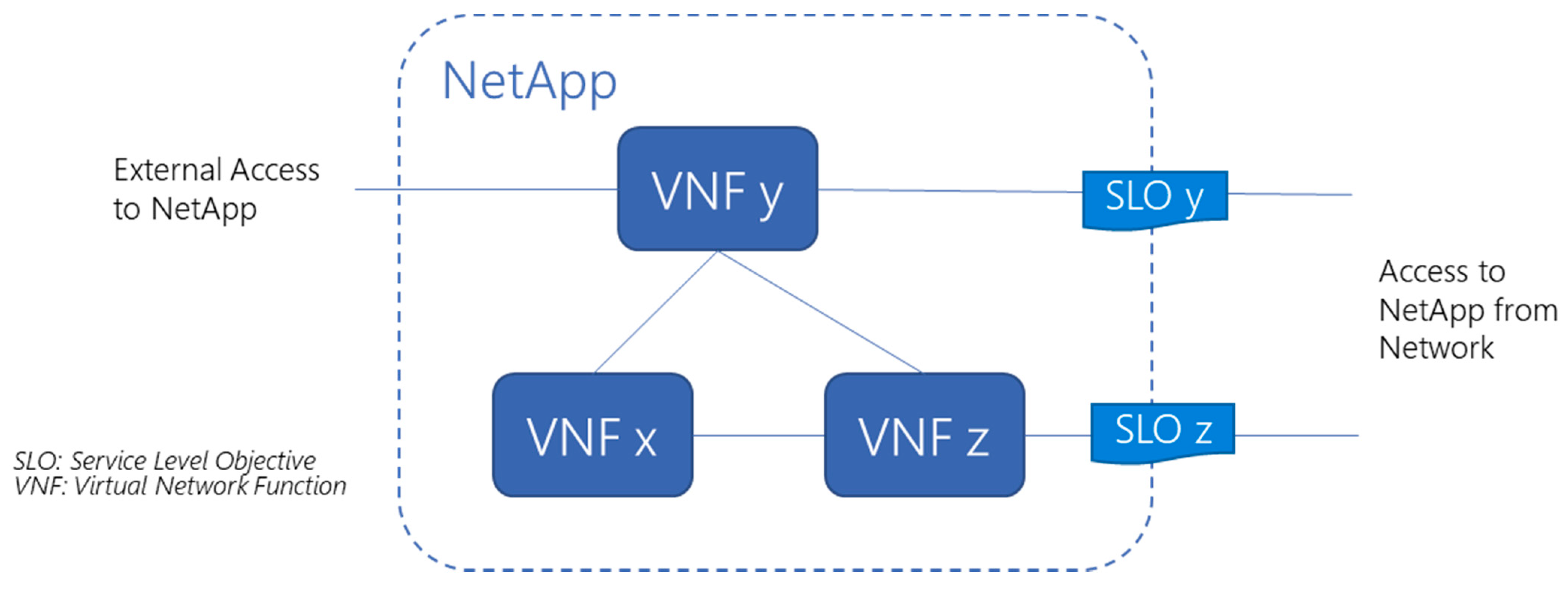
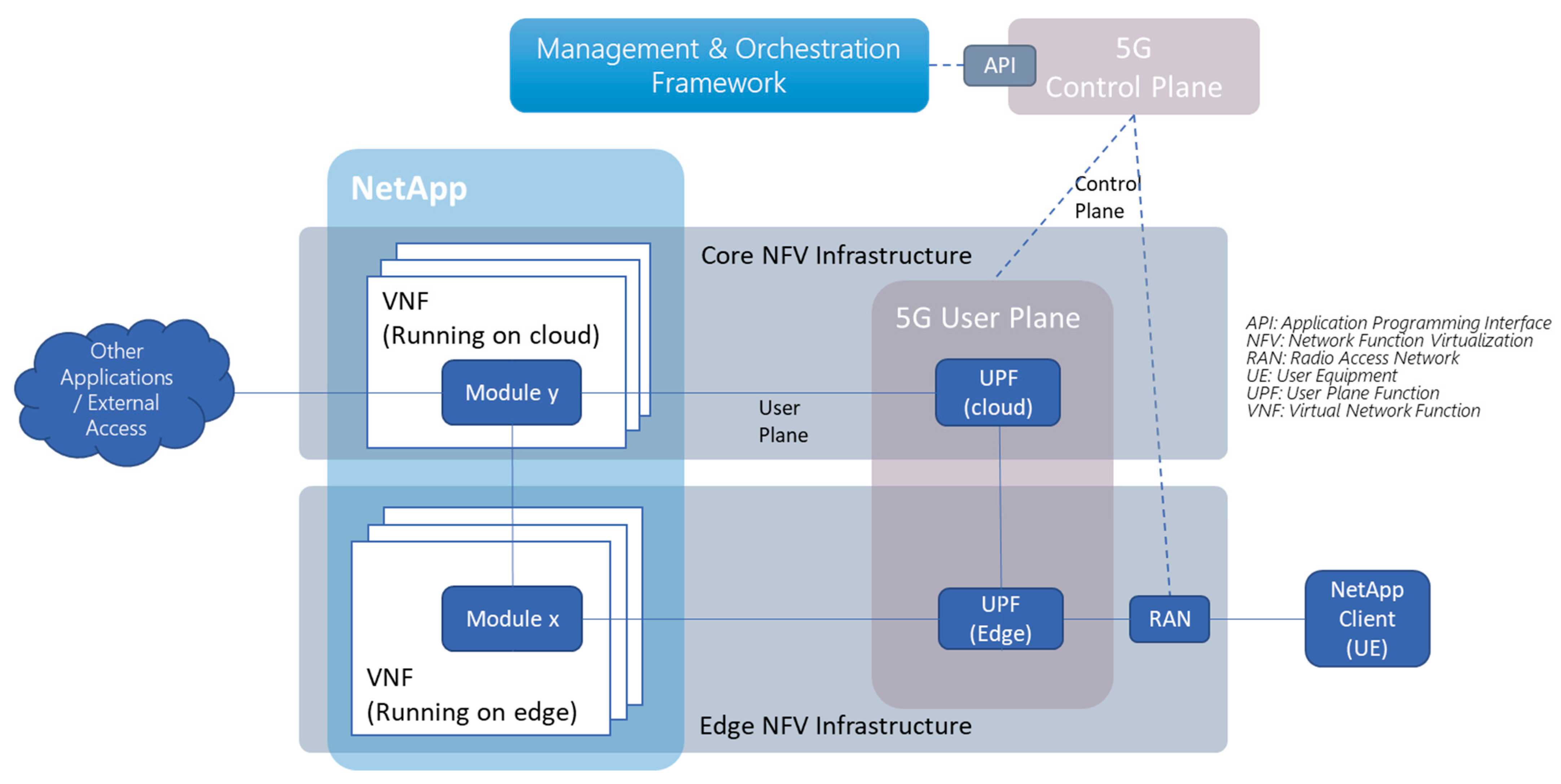
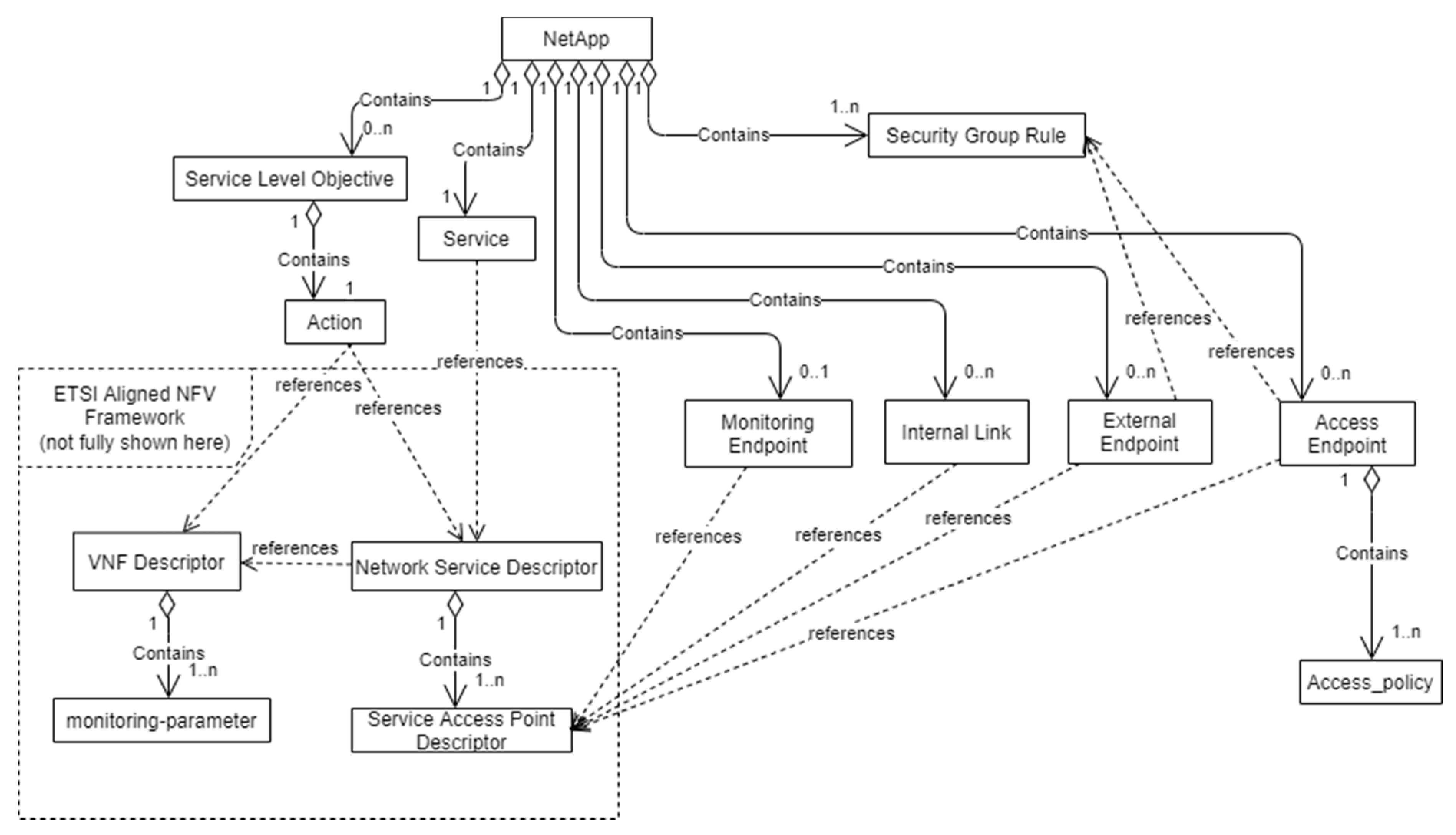
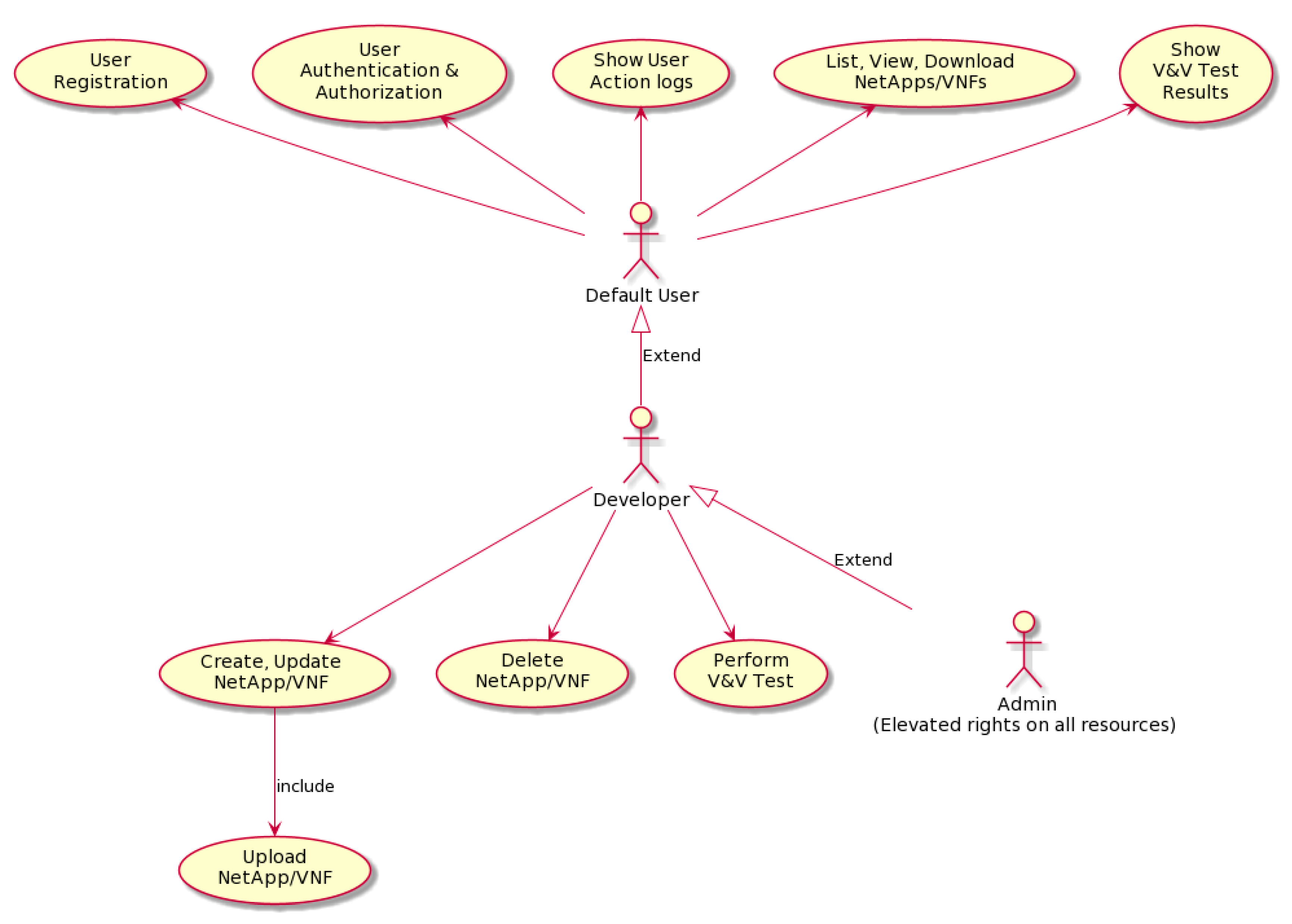
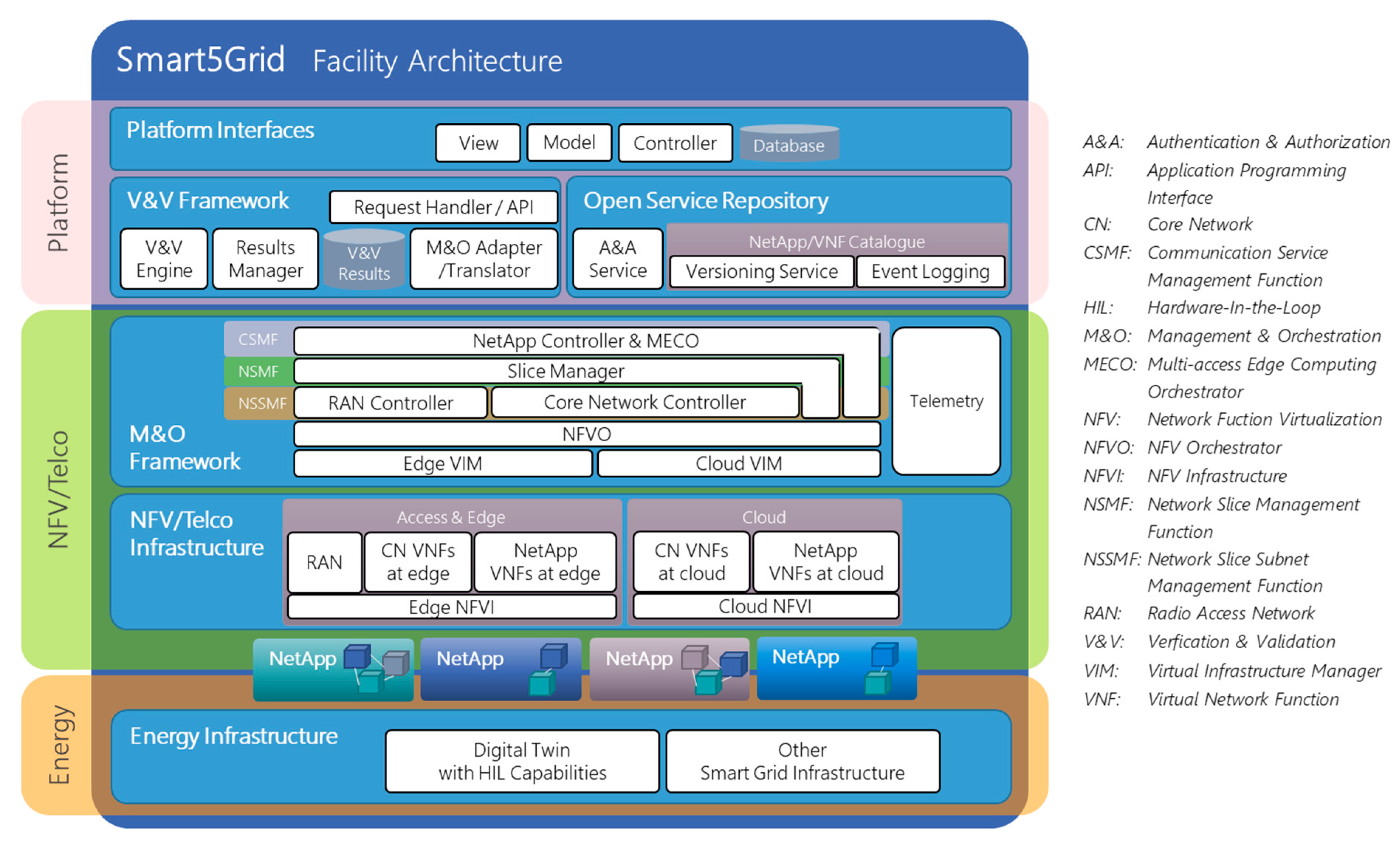
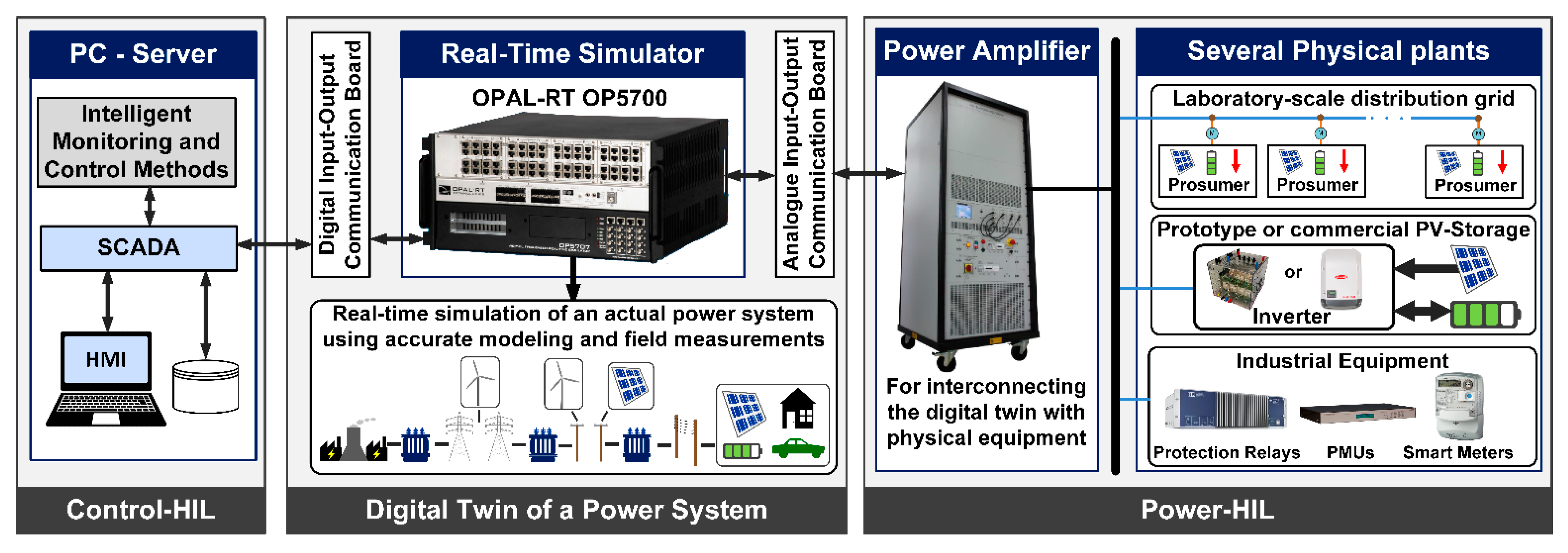

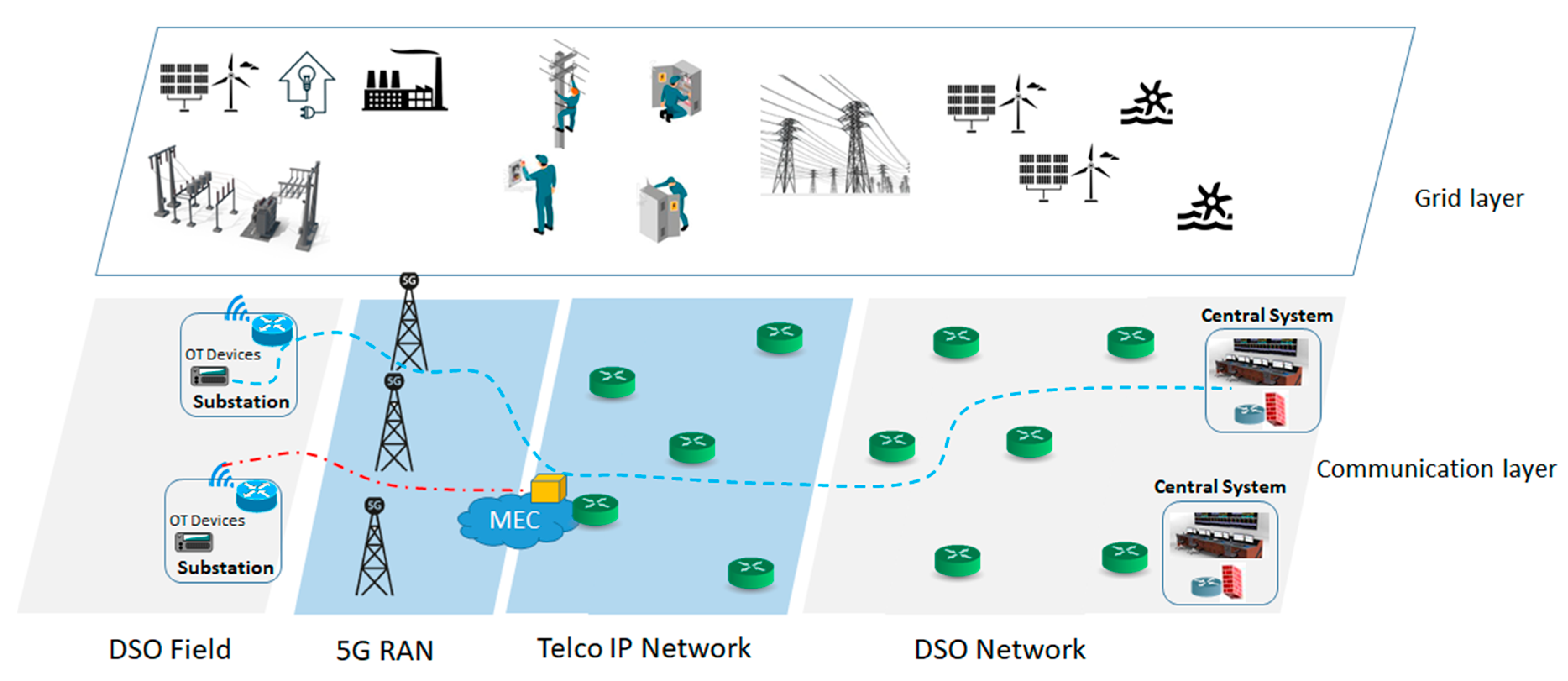
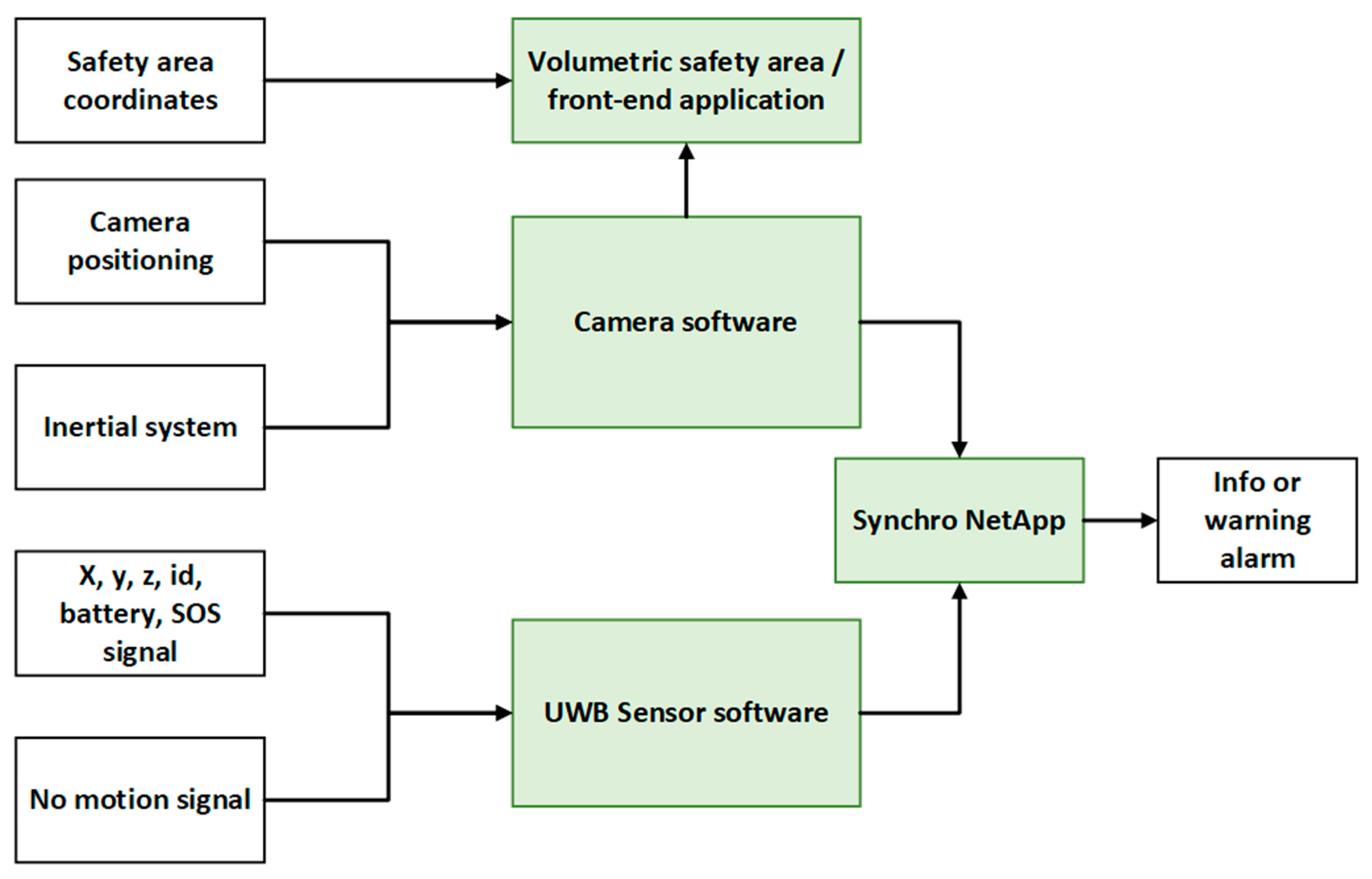
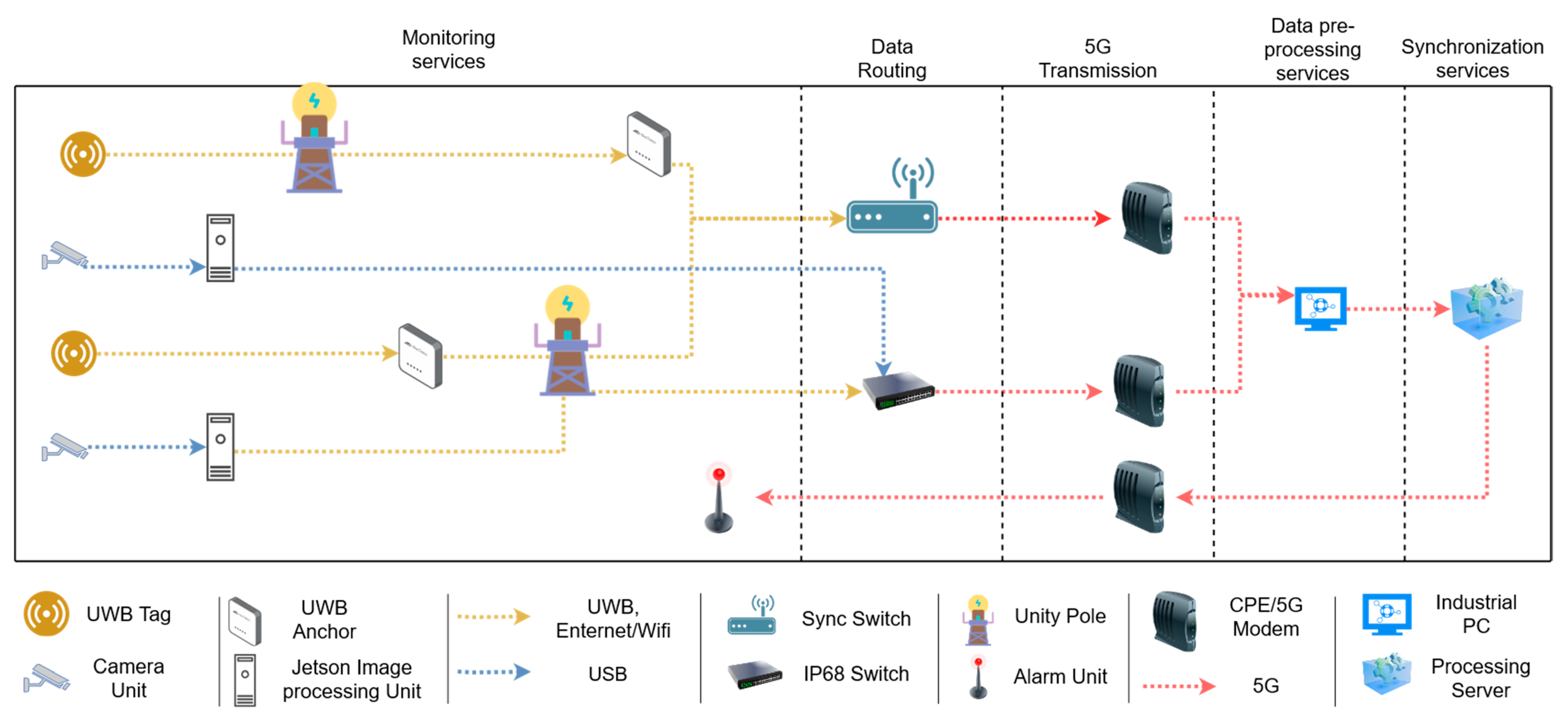
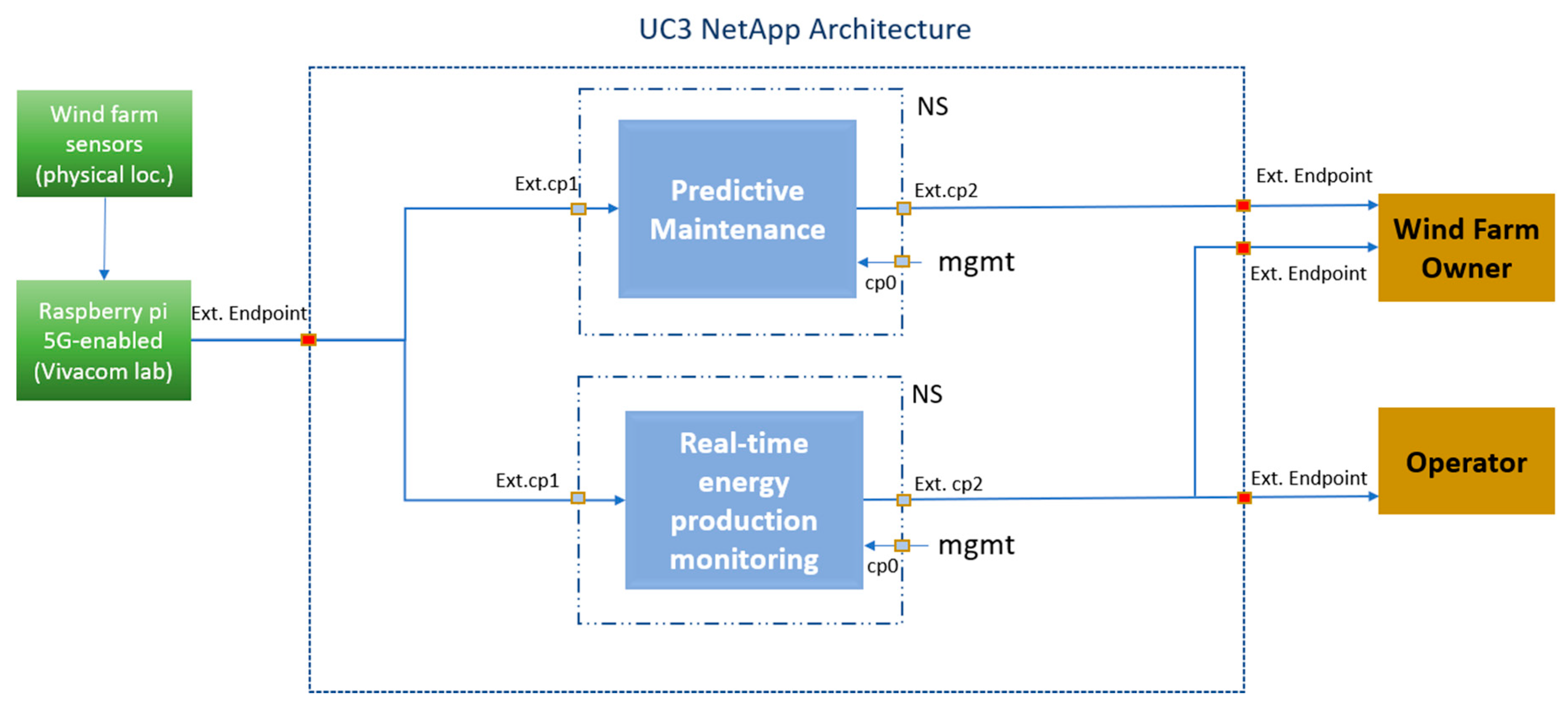
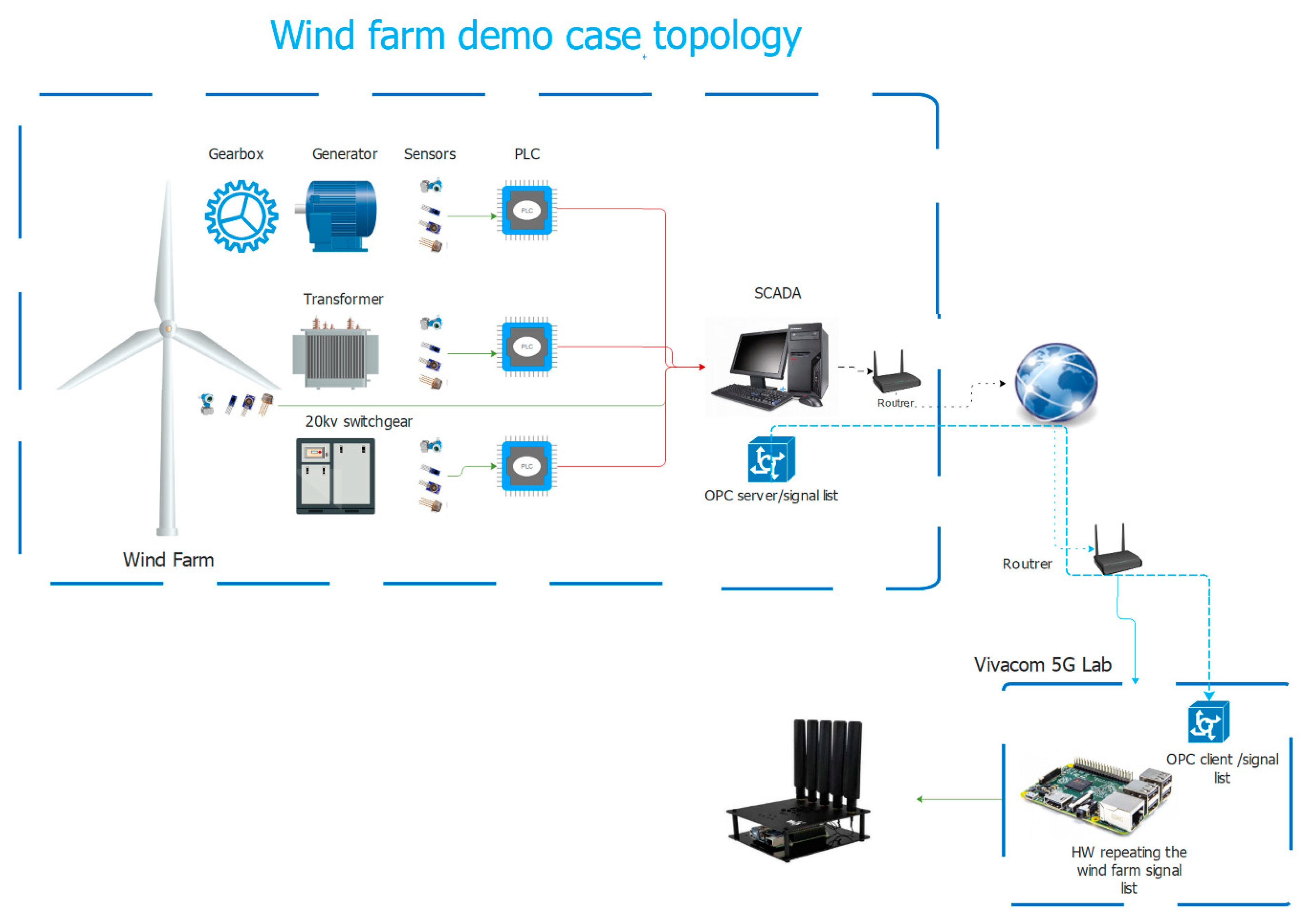
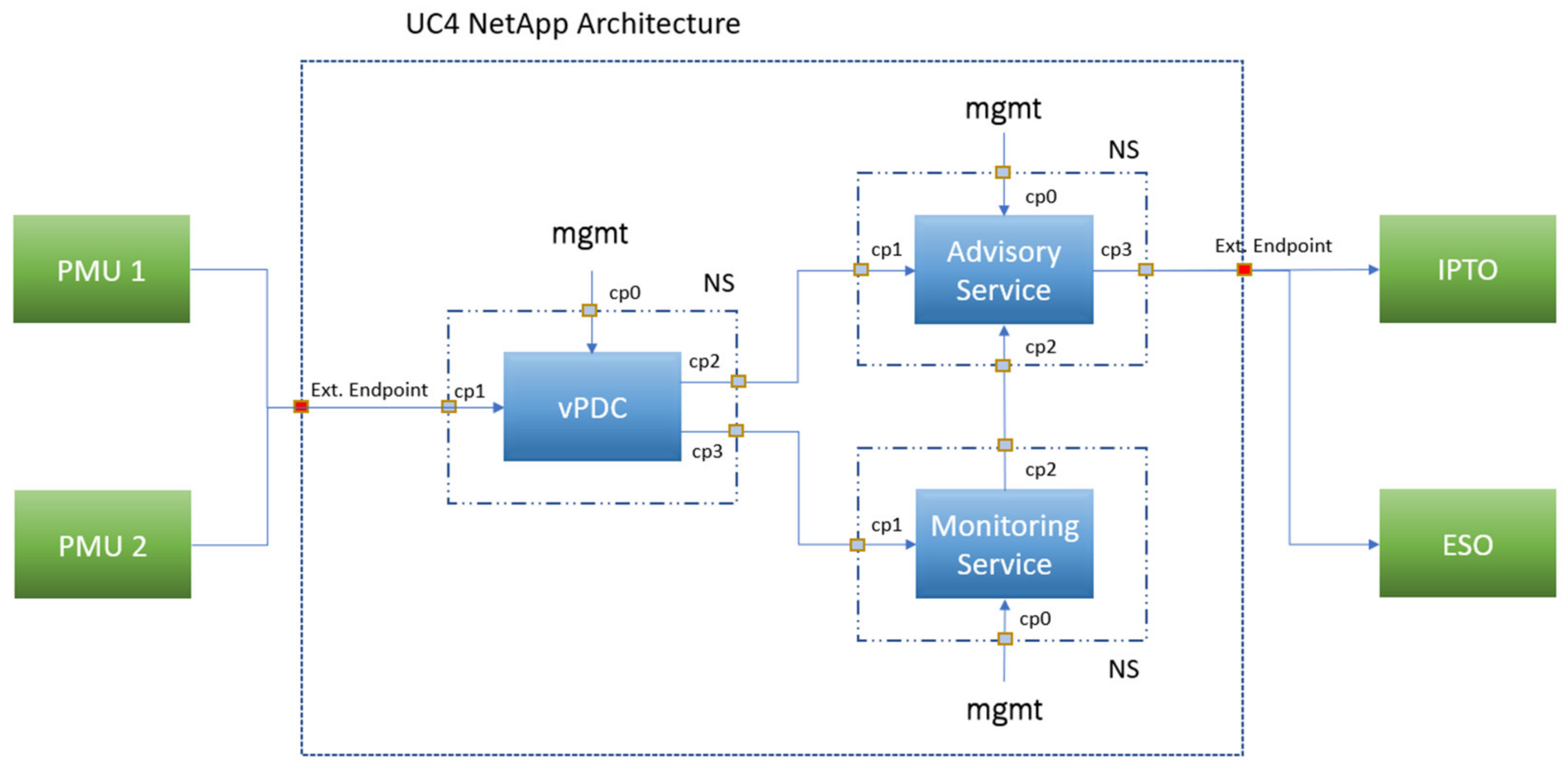
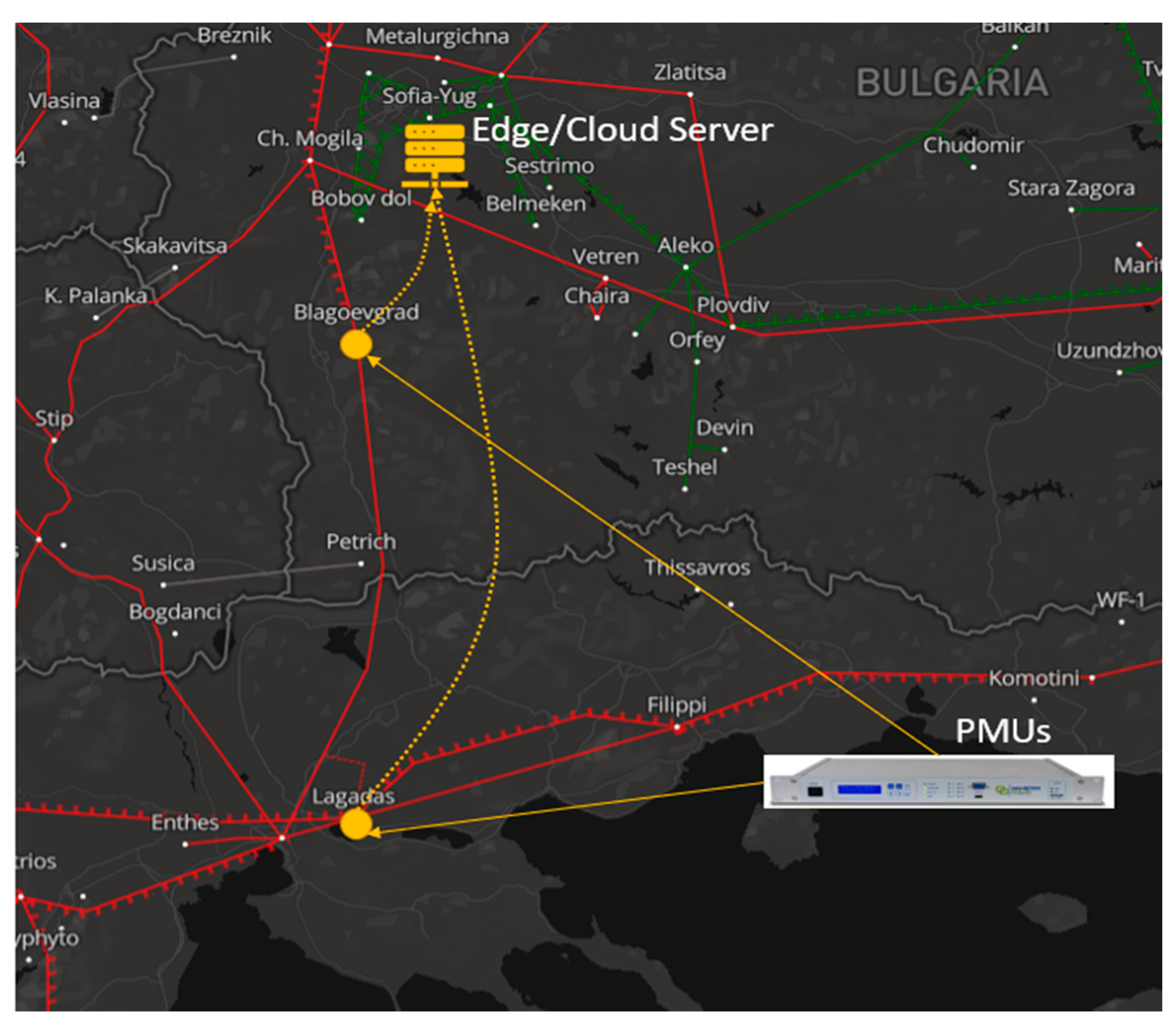
| UC1 | UC2 | UC3 | UC4 | |
|---|---|---|---|---|
| Title | Automatic Power Distribution Grid Fault Detection | Remote Inspection of Automatically Delimited Working Areas at Distribution Power Systems | Millisecond-level Precise Distributed Generation Monitoring | Real-Time Wide Area Monitoring |
| Type of Service | Continuous monitoring of the communication infrastructure | Inform workers on site for possible access in forbidden zone | Real-time monitoring and millisecond-level precision multiple DERs | Live monitoring of the power flows between countries |
| NetApp | Telecommunication network monitoring mechanism | Synchronization NetApp for real-time detection mechanism | Predictive maintenance service and real-time energy production monitoring service | Virtual PDC service, WAM service, advisory service |
| Goal | Troubleshooting process of the advanced self-healing power distribution automation system | Information collection and evaluation | Real-time data monitoring, easy replication to other types of RESs | Energy reliability and securing the domain of the broad energy vertical |
| Impact | Reduce complexity, time, and cost, ensure better electric service level, and optimize human resources’ involvement | Enhance safety measures and provide a safer working environment | Provide reliable flexibility services for real-time balancing electricity markets | Promote regional cooperation and support the strengthening of neighboring power systems and market operations in the region |
Publisher’s Note: MDPI stays neutral with regard to jurisdictional claims in published maps and institutional affiliations. |
© 2022 by the authors. Licensee MDPI, Basel, Switzerland. This article is an open access article distributed under the terms and conditions of the Creative Commons Attribution (CC BY) license (https://creativecommons.org/licenses/by/4.0/).
Share and Cite
Porcu, D.; Castro, S.; Otura, B.; Encinar, P.; Chochliouros, I.; Ciornei, I.; Hadjidemetriou, L.; Ellinas, G.; Santiago, R.; Grigoriou, E.; et al. Demonstration of 5G Solutions for Smart Energy Grids of the Future: A Perspective of the Smart5Grid Project. Energies 2022, 15, 839. https://doi.org/10.3390/en15030839
Porcu D, Castro S, Otura B, Encinar P, Chochliouros I, Ciornei I, Hadjidemetriou L, Ellinas G, Santiago R, Grigoriou E, et al. Demonstration of 5G Solutions for Smart Energy Grids of the Future: A Perspective of the Smart5Grid Project. Energies. 2022; 15(3):839. https://doi.org/10.3390/en15030839
Chicago/Turabian StylePorcu, Daniele, Sonia Castro, Borja Otura, Paula Encinar, Ioannis Chochliouros, Irina Ciornei, Lenos Hadjidemetriou, Georgios Ellinas, Rita Santiago, Elisavet Grigoriou, and et al. 2022. "Demonstration of 5G Solutions for Smart Energy Grids of the Future: A Perspective of the Smart5Grid Project" Energies 15, no. 3: 839. https://doi.org/10.3390/en15030839
APA StylePorcu, D., Castro, S., Otura, B., Encinar, P., Chochliouros, I., Ciornei, I., Hadjidemetriou, L., Ellinas, G., Santiago, R., Grigoriou, E., Antonopoulos, A., Cadenelli, N., di Pietro, N., Betzler, A., Prieto, I., Battista, F., Brodimas, D., Rumenova, R., & Bachoumis, A. (2022). Demonstration of 5G Solutions for Smart Energy Grids of the Future: A Perspective of the Smart5Grid Project. Energies, 15(3), 839. https://doi.org/10.3390/en15030839








